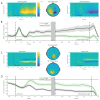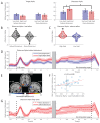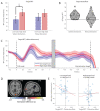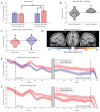Alpha oscillations reflect suppression of distractors with increased perceptual load
- PMID: 35533812
- PMCID: PMC7615060
- DOI: 10.1016/j.pneurobio.2022.102285
Alpha oscillations reflect suppression of distractors with increased perceptual load
Abstract
Attention serves an essential role in cognition and behavior allowing us to focus on behaviorally-relevant objects while ignoring distraction. Perceptual load theory states that attentional resources are allocated according to the requirements of the task, i.e., its 'load'. The theory predicts that the resources left to process irrelevant, possibly distracting stimuli, are reduced when the perceptual load is high. However, it remains unclear how this allocation of attentional resources specifically relates to neural excitability and suppression mechanisms. In this magnetoencephalography (MEG) study, we show that brain oscillations in the alpha band (8-13 Hz) implemented the suppression of distracting objects when the perceptual load was high. In parallel, high load increased the neuronal excitability for target objects, as reflected by rapid invisible frequency tagging. We suggest that the allocation of resources in tasks with high perceptual load is implemented by a gain increase for targets, complemented by distractor suppression reflected by alpha-band oscillations closing the 'gate' for interference.
Keywords: Alpha oscillations; Attention; Inhibition; MEG; Perceptual load.
Copyright © 2022 The Authors. Published by Elsevier Ltd.. All rights reserved.
Figures






References
-
- The Oxford handbook of attention The Oxford handbook of attention. Oxford University Press; 2014.
-
- Lavie N. Perceptual load as a necessary condition for selective attention. J Exp Psychol Hum Percept Perform. 1995;21:451–68. - PubMed
-
- Lavie N. Distracted and confused?: Selective attention under load. Trends in Cognitive Sciences. 2005;9:75–82. - PubMed
-
- Jensen O, Hanslmayr S. In: The cognitive neurosciences. 6th ed. Poeppel D, Mangun GR, Gazzaniga MS, editors. The MIT Press; 2020. The role of alpha oscillations for attention and working memory.
Publication types
MeSH terms
Grants and funding
LinkOut - more resources
Full Text Sources

